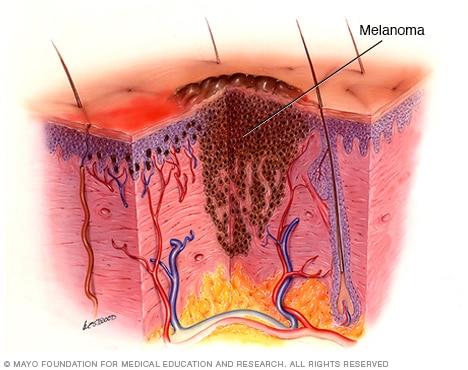Melanoma: Diagnosis and Treatment

Melanoma is a serious form of skin cancer that begins in cells known as melanocytes, that produce melanin – the pigment that gives your skin its color. While it is less common than basal cell carcinoma (BCC) and squamous cell carcinoma (SCC), melanoma is more dangerous because of its ability to spread to other organs more rapidly if it is not treated at an early stage.
How do dermatologists diagnose melanoma?
Physical exam. Your doctor will ask questions about your health history and examine your skin to look for signs that may indicate melanoma.
Removing a sample of tissue for testing (biopsy). To determine whether a suspicious skin lesion is melanoma, your doctor may recommend removing a sample of skin for testing. The sample is sent to a lab for examination by a dermatopathologist.
Stages of Melanoma:
Stage 0 (in situ): Melanoma is confined to the epidermis (top layer of skin).
Stage I: Melanoma is confined to the skin but has grown thicker. It can be as thick as 1.0 millimeter. In stage IA, the skin covering the melanoma remains intact. In stage IB, the skin covering the melanoma has broken open (ulcerated).
Stage II: Melanoma has grown thicker. The thickness ranges from 1.01 millimeters to greater than 4.0 millimeters. The skin covering the melanoma may have broken open (ulcerated). While thick, the cancer has not spread.
Stage III: Melanoma has spread to either: 1) one or more nearby lymph node (often called lymph gland) or 2) nearby skin.
Stage IV: Melanoma has spread to an internal organ, lymph nodes further from the original melanoma, or is found on the skin far from the original melanoma.
Sometimes the patient needs another type of biopsy. A type of surgery called a sentinel lymph node biopsy (SLNB) may be recommended to stage the melanoma. When melanoma spreads, it often goes to the closest lymph nodes first. A SLNB tells doctors whether the melanoma has spread to nearby lymph nodes. Other tests that a patient may need include x-rays, blood work, and a CT scan.
Treatment Methods:
Excision: When treating melanoma, doctors want to remove all the cancer. When the cancer has not spread, it is often possible for a dermatologist to remove the melanoma during an office visit. The patient often remains awake during the surgical procedures described below. The dermatologist numbs the skin. Then, the dermatologist surgically cuts out the melanoma and some of the normal-looking skin around the melanoma. This normal-looking skin is called a margin. There are different types of excision. Most of the time, this can be performed in a dermatologist’s office.
Treatment Outcome:
Melanoma is usually curable when detected and treated early. Once melanoma has spread deeper into the skin or other parts of the body, it becomes more difficult to treat and can be deadly. The estimated five-year survival rate for U.S. patients whose melanoma is detected early is about 99 percent.
Back to Skin Condition Library >